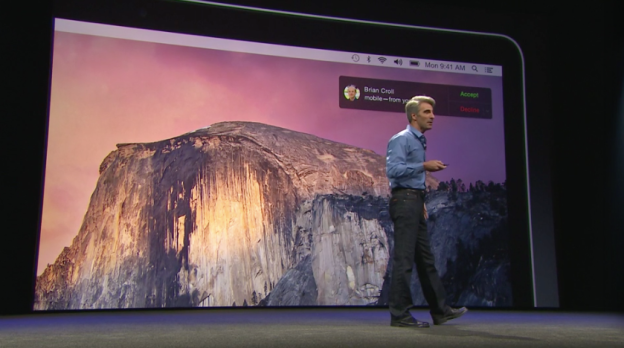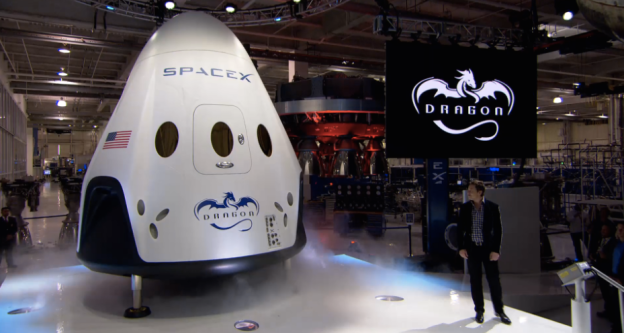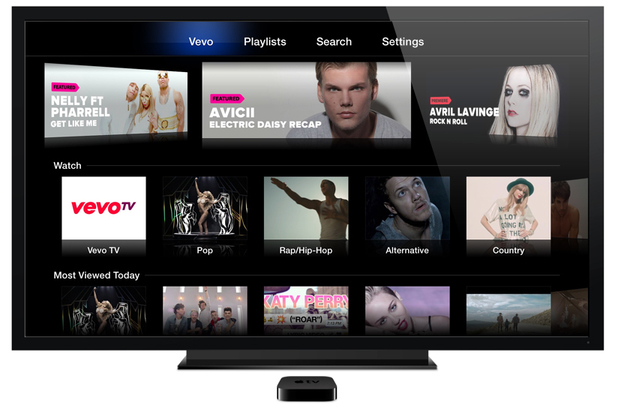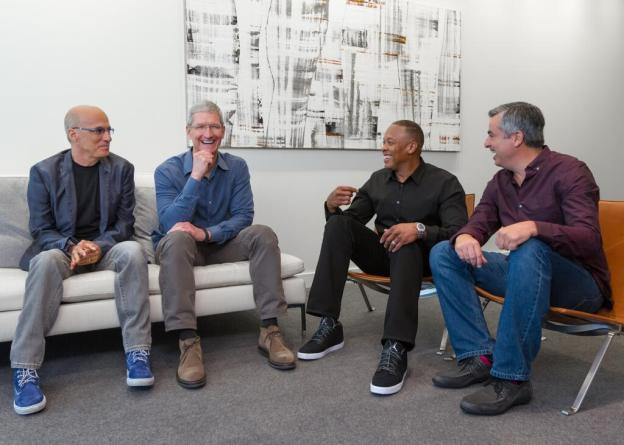Cool new features: connecting the iPhone to the laptop. check. Developers pay for early version, and final release is free. check. Apple gets prettier. check.


Cool new features: connecting the iPhone to the laptop. check. Developers pay for early version, and final release is free. check. Apple gets prettier. check.

I can’t wait to see this in action.

The players in the set-top box space are few and far between. Oh what a missed opportunity, but there are many more to come.

Apple is playing for keeps when they expand their content licenses and applications to other platforms; they are clearly in the music/video business as an end-to-end provider outside their hardware eco-system. Other companies whether hardware/software/or content providers can compete with a complete ecosystem. Apple will make their devices have the best experience – how can Rdio, Spotify, Samsung, HBO, compete even if they all partner. They can’t.

Today, I take an Uber to a Car2Go that is out of reach. I can’t wait for the day to summon a driverless car to pick me up and drive me to my destination. I’ll like this post when it happens.
And the watch wars begin, spawning the accessory to the phone – halo effect?
Watch out, Samsung: Google (s GOOG) has some smartwatch development projects of its own, and it quietly snapped up Los Altos, Calif.-based WIMM Labs last year to kickstart these efforts. WIMM Labs not only gives Google the talent and technology to build a smartwatch, but actually an Android-based app platform tailored for consumers’ wrists.
WIMM Labs was incubated around five years ago by Pillar Ventures, the investment company of former Rambus (S RMBS) President Dave Morring, who subsequently became WIMM’s CEO. The company first developed an Android-based developer platform for wearable displays, and then followed up in late 2011 with its own, developer-centric smartwatch dubbed the WIMM One.
But about a year ago, WIMM Labs suddenly went dark. The company deleted its Twitter accounts, stopped sales of the WIMM One, and published the following message on its website:
“During the summer of 2012, WIMM…
View original post 790 more words
It’s always interesting when two giants set aside their egos and collaborate on some deal or other. In this case, we have a software giant paying a second-to-Google superpower of search engines. Paying for what, though? Well, something called revenue-per-search or RPS. Or the shortfall that is associated with it.
The best way to understand the situation is to look back a few years, to 2009, when Microsoft and Yahoo first signed a search deal. Per this deal, Microsoft promised that Yahoo would earn a certain amount of money per search. When they didn’t hit the agreed upon RPS targets, Microsoft also agreed to make up the difference. In effect, they have been footing the bill for the last four years. And there are six more years to go, if the agreement is upheld to the end.
Why would Microsoft be in partnership for Yahoo, though, and why would it continue to make quarterly payments for a deal that clearly isn’t delivering the expected results? Other than being caught in a 10-year contract, there’s not much other reason.
Much of the issue has to do with Microsoft’s AdCenter and the technology they have in place for the buying and delivering of online ads. Basically, the system they use to push online ads really isn’t working as well as expected and never has. There’s considerable speculation whether Yahoo might actually go ahead and forge an alliance with Google to go ahead and work out the search engine ad problem. And even more speculation that they are hunting for a get-out-clause.
The real question we should be asking: why would Yahoo continue to partner with Microsoft when the foundation for the cooperation really isn’t there? Not only is Microsoft still falling short on its deal, it is also struggling to come up with much of a solution to improve the investment return.
As far as the partnership aspect goes, I think it is interesting that there is still any effort to keep the deal afloat. Perhaps it’s more that there really hasn’t been much of an effort – at least not an obvious one – to try and improve on Microsoft’s AdCenter.
The world of paid online advertising is certainly very tricky. With all the talk about grassroots campaigning and how people are just completely put off by paid online advertisements anyway, it’s a wonder anyone ever considers paying for advertisements at all. But that should be something, surely, that Microsoft and other invested companies are actually trying to solve. After all, grassroots advertising doesn’t work for everyone and it takes a lot of time.
Still, this partnership between Yahoo and Microsoft really isn’t moving things forward with RPS. Nor is the partnership apparently getting anyone anywhere.
While it is inspiring perhaps to see two major Internet based companies in partnership, (rather than what we have seen, for instance, with Amazon and Apple, at each other’s throats and battling over pittance), there are much better things that could come from these types of partnerships.
With the volume of start-up activity and number of individuals involved, founders would be smart to employ new services that use online work-flows and back-ups to manage various corporate transactions.
Two such services for corporate records automation have come to the market recently and I’d thought I ‘d mention them and also cite another area of innovation that the start-up community could benefit from.
The first to start-up with is Clerky.com: According to their website, they provide incorporation services, form corporation documents, and electronic signing. Limiting only to incorporation in Delaware. Concerns are raised for other legal issues that may crop up regarding arbitration jurisdiction.
The second, recently announced, is Glider.com: Contract workflow processes. Whether this service handles contract generation or just document management, if the service will eventually handle contract forms and use templates like the aforementioned Clerky.com – or strictly contract management and collaboration and electronic signatures remains to be seen. The space for business services with legal documents is certainly active.
The trend for online services to expand the scope of the successful Legalzoom.com reach, could ostensibly happen by including workflow and electronic signing.
Another area of innovation that founders would benefit: a corporate board minutes system, keeping track of notes, board resolutions, e-signature for each of the members, automatic shareholder ratifications. And most importantly, back-ups so that corporate records don’t go missing.
Gmail has had a discovery litigation back-up tool called Postini.com. No doubt that has been the main repository for corporate documents to date for those doing start-ups. Founders would be wise to be careful and diligent about backing up, and keeping strict records regarding corporate actions, lest dissenters take the lack of information to their advantage.
The current Kickstarter campaign by Scrubs’ Zach Braff, Wish I Was Here, is a rocket success. At the time of writing, it has hit $1.5 million and 20,000 backers. (http://kck.st/11F6V1Z).
They’ve reached their $2 million goal in a month, and it’s great! Great for customers, “friends and family” supporters, and also really great for Mr. Braff, allowing him to keep creative control of his work.
At the same time, though, this approach to fund raising and the JOBS Act create various pros and cons for equity-based crowdsourcing.
The Kickstarter fund raising path is all about promising the customer a product both during and after the path of the project’s development.
The customers of Mr. Braff’s movie get value in a somewhat unconventional fashion but it is value that they willingly accepted, knowing the conditions of the product at the sale. Pledging $5,000 to attend the premiere and have Mr. Braff’s hand on your leg is a steal. Not including the t-shirt, art prints, sound track, weekly playlists, Production diary, and the script.
Purchasing equity, though, you might find yourself being more critical and somewhat more concerned with what Mr. Braff is going to do to manage the money. You start wondering, well, why should there be t-shirts at all? What is Mr. Braff doing at a Premiere, potentially creating a sexual harassment liability? Why is he not working on casting Batman and wowing Asian fans?
Purchase equity and you’ll also have full expectation of transparency and future returns. When there is any deviation from the plan, heads will roll. And that changes the project forever…even when you disclose to shareholders that you are absolutely maintaining complete creative control.
And right now, Mr. Braff certainly does have complete creative control, complete decision-making. It makes all the difference.
Since the passing of the JOBS Act, though, the SEC has been slow to sort out the rules. According to numerous articles (http://politi.co/10fl2Ha), the whole thing is a “giant mess” (actually, those were the words of a congressional aide, which says a lot in itself).
If the current SEC rules can’t spot fiduciary breaches, related party exchanges, or off-shore holdings, with the current regulations and reporting requirements, making crowd-sourcing a part of it, putting it under SEC scrutiny, would truly make an unbearable problem for the agency.
The web has circulated a few rumors about possible digital watch initiatives recently. What a great starting point for my blog! I first got involved in the development of smart watches many years ago but here is my run down of what’s going on at the moment.
First off, we know that Sony has shipped out their best effort to date (http://engt.co/13Jl02g). Samsung is rumored to be building its own watch (http://abcn.ws/12yYeYi), as are Apple and LG (http://bit.ly/17QXNec), and even Microsoft (http://bit.ly/120i8dy).
The Microsoft team that originally created the SPOT Watch back in 1999 laid the foundation for much of the subsequent innovation in smart watch designs. The recent Kickstarter campaign for the Pebble (http://kck.st/11BJkfK) caught everyone by surprise when it showed that there was actually a large consumer market (68,929 backers) willing to spend over $10 million to see the smart watch get where it needed to be. And all this started with the ground breaking 1990 Seiko Message Watch, using the so-called “FM subcarrier” network (Seiko HSDS Whitepaper). For a particularly cool overview of the development of the smart watch, checkout: http://ow.ly/kica6.
What is interesting about the smart watch, though, and what actually makes it smart?
Well, consumers haven’t generally taken to digital watches with all that much zeal. At least, that’s the historical trend. Watches are items of jewelry, first and foremost. People don’t buy them for the technology. Or they haven’t yet.
But the market is saturated with high-end jewelry watches. What’s out there now is high-end mostly in terms of the fine mechanics in the design and the precious stones and metals.
The digital watch is a whole different story. You see calculator watches, sports watches. With the exception of Suunto GPS high-end watches, you don’t really see much else that is what you would call overly smart. When it comes to the smartness of that watch, nothing that will fit on your wrist will out compute your phone or a phone connected cloud app.
Technology companies love the smart watch, though. It’s thing to watch because your wrist is prime real estate in the technology world. Okay, Google Glass is going for your face. Apple and the Smart Phone industry are vying for your pocket. Nonetheless, everyone wants that spot on your wrist.
What should you expect a smart watch to do, though? What can it do to really stand out when you have your cell phone and iPad or tablet on hand as well?
Obviously, a watch is strapped to your wrist…but what are other similar trends in the wearable computing area? The fitbit, Jawbone Up, Nike Fuel Band, and other wearable computing devices promise to track your every move and translate them to some digital calorie to burn or digital fitness score. This is the world of Digital Wellness. These devices have little to no interface, save one button and some feedback – blinking LED and a vibrator. And they differ in price considerably, based on whether they Bluetooth the data to your phone or plug into a headphone jack.
Should the smart watch be connected via FM Subcarrier, Bluetooth, or wifi? This decision directly impacts size of the battery and how often the device needs to be charged. How often should the watch be charged? Once a day, once every 3 days, once a week? Is it possible not to charge the watch more than once every month?
Should the device have sensors GPS, accelerometers, humidity – like the exercise bracelets we mentioned? Or if it is connected, why not send the data to the watch, and just track local position?
Should the watch be an mp3 player and have a headphone jack like the Apple iPod shuffles?
What market should the watch focus on? High-end jewelry, extreme sports, technical geek?
A strangely popular trend in Fossil watches in the early 2000 was the dynamically changing LCD see http://bit.ly/13JnUE9. This really set the trend for digital Fossil watches. Not surprising they were first adopters in the Microsoft SPOT watch initiative. What type of display should it have? High resolution full color or eInk? A few colors, perhaps, or an array of LEDs like the Nike Fuel band? How about touch screen or gesture control?
This is a market ripe for multiple configurations like the iPod, from no interface (Jawbone Up or original iPod shuffle) to the high resolution retina display, with storage in modest flash to massive HDD. The smart watch configurations may differ by connectivity, display, and memory types.
A couple of things are certain. A smart watch has to tell time, it has to fit on the wrist, and it has to be as close to jewelry as possible. People have got to value it. It has to be precious.
Any smart watch we see emerge in the next while is going to need a high resolution display, touch-gesture control, and Bluetooth connectivity to the phone. It’s basically a smart phone accessory; and the best smart watch will have the best set of apps that not only work on the watch, but the paired phone.